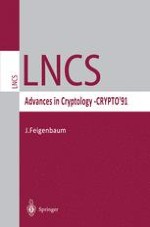1992 | OriginalPaper | Chapter
New Results on Pseudorandom Permutation Generators Based on the Des Scheme
Author : Jacques Patarin
Published in: Advances in Cryptology — CRYPTO ’91
Publisher: Springer Berlin Heidelberg
Included in: Professional Book Archive
Activate our intelligent search to find suitable subject content or patents.
Select sections of text to find matching patents with Artificial Intelligence. powered by
Select sections of text to find additional relevant content using AI-assisted search. powered by
We denote by ψk the permutation generator based on the DES Scheme with k rounds where the S boxes are replaced by random independant functions. We denote by |P1 − P1*|, (respectively |P1 − P1**|), the probability of distinguishing such a permutation from a random function (respectively from a random permutation) by means of a distinguishing circuit that has m oracle gates.In 1988, M. Luby and C. Rackoff [1] proved that $$ \forall k \geqslant 3,|P_1 - P_1^* | \leqslant \frac{{m(m - 1)}} {{2^n }}. $$At Eurocrypt 90, J. Pieprzyk wondered at the end of his paper [4] if that inequality could be improved. This is the problem we consider here. In particular, such an improvement could greatly reduce the length of the keys used in a “direct” application of these theorems to a cryptosystem.Our main results will be: 1.For ψ3 and ψ4 there is no really tighter inequality than $$ \leqslant \frac{{m(m - 1)}} {{2^n }} $$ .2.However for ψ5 (and then for ψk, k ≥ 5), there is a much tighter inequality than Luby - Rackoff’s one. For example for ψ6, |P1 − P1*| and |P1 − P1**| are $$ \leqslant \frac{{12m.}} {{2^n }} + \frac{{18m^3 }} {{2^{2n} }} $$ .3.When m is very small (m = 2 or 3 for example) it is possible to have an explicit evaluation of the effects of the number of rounds k on the “better and better pseudorandomness” of ψk.
